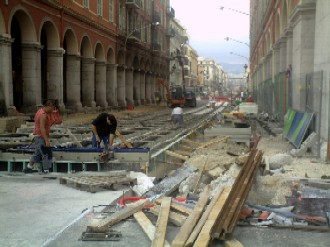“Help, it’s a nightmare!” The cry from Christophe Mazza sets the tone. Holes, bumps, rubble, sidewalks reduced or even blocked… For a disabled person, getting from one point to another in Nice is like an obstacle course. Forgotten or even ignored, people with reduced mobility are “fed up to the seat.” Doing their shopping, entering the building of their doctor, or simply strolling around, daily movements have become more than limited.
The blind, on the other hand, are lost. For visually impaired people, crossing Avenue Jean Médecin to reach the civil union of the blind has become a nightmare. “I found myself in a hole,” recounts Valérie Parola, president of this association. Lack of sound signals, destroyed tactile indicators: the blind have lost all their bearings. “Even my guide dog is confused. One day, we have to take one sidewalk, the next day, another. Sometimes I have to ask passersby where I am!”
As a volunteer for the French Association of Paralyzed People (APF), Christophe Mazza is trying to make things evolve, “but nothing is moving… Except for the excavators, trenches, and the direction of traffic.” According to him, “the work is poorly thought out, not complying with legislation.” THEY, Christophe specifies, are the Town Hall and the CANCA. “No need to remind who mandates these two administrations, provided the message gets through.” Armed with determination, associations are multiplying their efforts. “We repeat, we ask, we send letters.” To no avail.
But why so much acrobatics?
There is indeed a law imposing a quality charter for construction work. A commission responsible for controlling accessibility has even been created. Representatives from the APF and the Civil Union of the Blind are members of it, as well as the DDE (Departmental Directorate of Equipment) and the DDASS (Departmental Directorate of Health and Social Action).
The message, however obvious, is not getting through. And finding out about the arrangements made for the disabled requires… flexibility.
Dominique Caramico, head of the city’s handicap service, explains that “when the work began, rules were established to respect pedestrian movements. In practice,” she continues, “it’s different. But inquire at the CANCA, they manage the work.” Fine. At the communication service of the agglomeration community, the spokeswoman is “embarrassed.” She “doesn’t know the file.” On the side of the DDASS “it’s impossible to answer journalists without a prefectural authorization.” Obliged by the state agency.
In short, even if “things need to be done” as Valérie Parola acknowledges. Place Garibaldi, the place of the Rhine Army, or Boulevard Jean Jaurès remain “either impassable or dangerous, it’s exhausting.”



